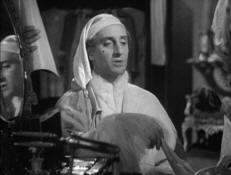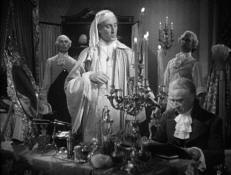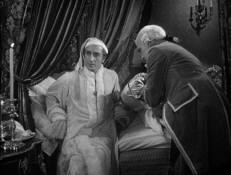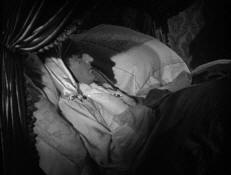Page Two of
|
|
Metro achieves in "A Tale of Two Cities" a screen classic which for sheer dramatic force excels in thrills the various horror stories which the country has profitable absorbed. This being so, there seems to be little reason why the terrific grip of this tragic story of renunciation should not fare very well. Technically it is about as flawless as is possible. The story is carefully dragged from the mass of literature in Dickens' three-volume day. It has been assembled with intelligent skill and then turned over to a lengthy cast almost without exception capable of realizing, in the flesh, the quaint characters of the novelist. It has been made with respectful and loving care. Even the two yawning pitfalls of spectacle and dialog have been adroitly evaded. The fall of the Bastille is a breath-taking screen picture, but it is given no greater valuation than its influence on the plot warrants. The rabble at the guillotine is blood-chilling in its ferocity, but not for a moment does it overlie the principals, waiting in the shadow of the bloody platform for their turn to come. In the dialog the lines are neither the often stilted phrases of the book, nor yet the colloquial language of today. It is a happy compromise which always fits and only once does a scene bring a laugh where it should not. This is in the fight between Edna May Oliver and Blanche Yurka. The fall from the table draws an ill-timed chuckle. It may have purposely been planned to break the horror of the scene, but from an artistic point of view it is regrettable. On the other hand, in spite of the drear sadness of the theme, there is a distinct and non-intrusive comedy thread, mostly contributed by Miss Oliver, who does valiant service in keeping the tension from the breaking point. Possibly as a sop to the desire for happy endings, the execution of Carton is softened. The boom camera rises above the top of the guillotine on a panorama of Paris, with a title closing in, and Carton's famous lines spoken as the title runs. The device is effective. Another matter for which the spectator is to be devoutly thankful is the omission of any farewell between Lucie and Carton, which must inevitably have spoiled those splendid fine moments. The production is outstanding, not alone for the skill with which the major action has been handled but for the adroitness with which director Jack Conway has managed the background action. It is never intrusive, yet there is none of the bare stage effect that too often is shown in some other pictures. The cameraman rate mention for his appreciative use of angles, and a nod also should go to the scene constructors. With so long and so excellent a cast it is impossible to give credit wherever it is due. Ronald Colman makes his Carton one of the most pathetic figures in the screen catalog. Gone are his drawing room mannerisms, shaved along with his moustache. He makes the figure likeable, pathetic and intensely sad while going through most of the picture with a smile on his face. Henry B. Walthall is good as Manette and Blanche Yurka magnificent as the vengeful Mme. De Farge. On the other hand Lucille Laverne gets out of the picture through over-emphasis. Old stage tricks assert themselves. Miss Oliver never gets quite the chance she enjoyed in 'Copperfield,' but she makes every line count. The others all are good, each in proportion to assignment, with Elizabeth Allen suffering somewhat from necessity for being so typically a Dickens' heroine. But that was her job and she acquits herself admirably. Isabel Jewell gets a brief, but highly effective moment as the girl who goes with Carton to the shambles. Chic. —Variety, January 1, 1936 |
"Basil Rathbone is a very model of cold hauteur as the cruel Evremonde." —Andre Sennwald, The New York Times, December 26, 1935
"Immortal story brought to the screen with an overwhelming power and beauty that make the world-shaking chapter of history a living and shattering reality. ... There is not a box-office in this country, and few in other lands, that will not be enriched by this presentation." —Hollywood Reporter, December 1935
 The Marquis complains about peasants not paying their debts to him. |
 "I can hardly afford my perfume bill." |
"In its wealth of detail and painstaking fidelity to the atmosphere, settings costumes and customs of the period, the picture is most interesting. The mob scenes and the dreadful conditions among the poor of Paris are almost too horribly real. The characters are well cast and adhere closely to our conception of them as Dickens wrote them into his novel." —Motion Picture Reviews, December 1935
|
The Tale of Two Cities will probably bring to a worthy climax the cycle of Dickens' novels filmed by Metro and Universal. The Projection Room liked David Copperfield more than The Tale, through M-G-M spared no effort to make this picture starring Ronald Colman the artistic and dramatic equal to Freddie Bartholomew's film. However, this should not detract from the laurels due to Colman. As the obscure London attorney who has sought refuge from the stupidity of mankind in the liquor that has made his life worthless, he is superb. His love for Elizabeth Allan, as Lucie, gives him the incentive to make the one gesture which could cancel the emptiness of a misspent life, and Colman lays his neck on the guillotine to save Lucie's husband. The cast is indeed illustrious, with Edna May Oliver, Blanche Yurka, Isabel Jewell, Reginald Owen, Basil Rathbone, Henry B. Walthall, Donald Woods, Walter Catlett and many others. E.E. Clive, in a brief bit, won applause. The setting and background action of the picture—showing the storming of the Bastille, a huge Revolutionary courtroom, the mobs striking down the aristocrats are handled with tremendous power by Jack Conway in his masterful direction. But the constant menace of the guillotine—you see its shadow everywhere in this bloody period of France—brings a depressing sensation that is lifted only by the emotional climax of Ronald Colman's sacrifice. —Hollywood, February 1936 |
"Sidney Cartons' noble sacrifice of his worthless life to save the husband of the woman he loved is pictured with a directness and sympathy that should make [A Tale of Two Cities] a popular film. The colorful and exciting period of the French Revolution gives the film a sweeping, actionful background. ... 'Two cities' boasts an almost perfect cast." —Independent Exhibitors Film Bulletin, January 1, 1936
 "Oh, you think one man is as good as another." |
 The Marquis hears a noise. |
"Dickens' story mounts to epic proportions. M-G-M, sweeping the country with many fine productions, have added this stupendous story to their growing list of successes. It will be hard to equal for real entertainment." —Showmen's Trade Review, December 1935
|
A great and magnificent picture! Charles Dickens' immortal story of the French Revolution comes to the screen with overpowering beauty and breath-taking potency. Produced by David O. Selznick who, not long ago, gave us "David Copperfield," neither money nor talent has been spared on this production, and under the inspired direction of Jack Conway the most blood-thirsty chapter of modern history is brought to life in all its thrilling splendor and mighty reality. It is no Cecil B. DeMille "Spectacle." The characters are of dominant importance, and although there must be twenty or more of them outstanding, all are individualized, all live and breathe just as they did in the pages of the book. The story, as you recall, takes place in London and Paris in 1789 on the eve of the Revolution, and then proceeds to the storming of the Bastille, the Reign of Terror, and—the Guillotine. You probably remember your Dickens, anyway there is not enough space to go into the plot, which is truly a fascinating one. The old die-hards will be pleased to know that Metro has not changed a syllable of Charles Dickens' famous novel. Ronald Colman leads the illustrious cast and as Sydney Carton gives a flawless performance that runs the entire gamut of emotions but never rings false. When he utters those unforgettable words at the guillotine—"It is a far better thing that I do, than I ever have done. It is a far better rest that I go to than I ever have had"—you feel that you just can't stand it, you've got to cry or tear your handkerchief or something. Elizabeth Allan as sweet Lucie Manette is lovely and appealing. Henry B. Walthall plays Dr. Manette, and his plea for his son-in-law before the tribunal is a masterpiece. Edna May Oliver makes plenty of her peppery and tart remarks and is excellent as Miss Lucie's friend and guardian. Reginald Owen reaches a new high as Carton's law partner, utterly devoid of a sense of humor. Then there is Blanche Yurka, making her screen debut, as the blood-thirsty Madame LaFarge who knits while the aristocrats' heads fall into the basket, and Donald Woods as handsome young Charles Darnay, the beloved of Lucie Manette, and Isabel Jewell as the little seamstress who goes to the guillotine hand in hand with Sydney Carton. There's E. E. Clive giving an inimitable Chief Justice, and Claude Gillingwater as the English banker, and Walter Catlett as the spy, Fritz Leiber as the revolutionist, H. B. Warner as the teacher, Basil Rathbone as the foppish Marquis, Billy Bevan as the cockney "resurrectionist, etc., etc. You can't afford to miss this really great picture. —Silver Screen, February 1936 |
"Excellent. It is an outstanding picture. The scenes that show the gathering of the mobs of the French Revolution are something that people will not soon forget; so thrilling are they. Several of the situations bring tears to one's eyes." —Harrison's Reports, December 28, 1935
A Tale of Two Cities is "a first-rate example of the production quality typical of big-budget Hollywood studio films of the mid-1930s, particularly the ones from MGM." —Richard Gilliam, https://www.allmovie.com/movie/a-tale-of-two-cities-v48478/review
See Page Three for pictures of posters, lobby cards and promo photos.











